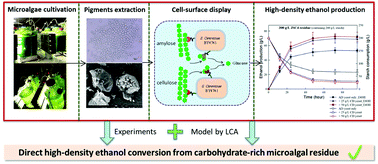当前位置:
X-MOL 学术
›
Green Chem.
›
论文详情
Our official English website, www.x-mol.net, welcomes your
feedback! (Note: you will need to create a separate account there.)
Fermentation of pigment-extracted microalgal residue using yeast cell-surface display: direct high-density ethanol production with competitive life cycle impacts†
Green Chemistry ( IF 9.3 ) Pub Date : 2019-11-04 , DOI: 10.1039/c9gc02634g Xiaochen Huang 1, 2, 3, 4, 5 , Shunwen Bai 1, 2, 3, 4, 5 , Zhuo Liu 6, 7, 8, 9, 10 , Tomohisa Hasunuma 8, 9, 10, 11, 12 , Akihiko Kondo 6, 7, 8, 9, 10 , Shih-Hsin Ho 1, 2, 3, 4, 5
Green Chemistry ( IF 9.3 ) Pub Date : 2019-11-04 , DOI: 10.1039/c9gc02634g Xiaochen Huang 1, 2, 3, 4, 5 , Shunwen Bai 1, 2, 3, 4, 5 , Zhuo Liu 6, 7, 8, 9, 10 , Tomohisa Hasunuma 8, 9, 10, 11, 12 , Akihiko Kondo 6, 7, 8, 9, 10 , Shih-Hsin Ho 1, 2, 3, 4, 5
Affiliation

|
Microalgae have attracted increasing attention as a potential feedstock for biofuel production. However, direct high-density ethanol production from microalgae is not commercially feasible due to the requirement for complex pre-treatments and insufficient enzymatic hydrolysis. In this study, we successfully developed a consolidated bioprocessing (CBP) system using recombinant Saccharomyces cerevisiae displaying synergistic cellulases/amylases on cell surfaces to overcome energy-conversion limitations. As Chlamydomonas sp. JSC4 can accumulate considerable amounts of carbohydrates and pigments (i.e., lutein), performing four rounds of pigment extraction from wet microalgal biomass using acetone was found to significantly eliminate the need for biomass pre-treatment and increase commercial viability. The pigment-extracted JSC4 residues increased ethanol production by 10.7% and 31.6% compared to raw starch and whole JSC4 cells, respectively. The theoretical ethanol production mass and yield from 300 g L−1 of JSC4 material were 73 g L−1 and 64%, respectively, after fermentation for 72 h in the presence of amylase- and cellulase-displaying yeasts, which are dramatically higher than those reported previously. Life cycle assessment (LCA) further revealed that this CBP system has 2.7- to 10.7-fold lower total environmental impact compared to alternative ethanol production methods using microalgal biomass. 2.43 kg ethanol and additional products of 5 g lutein from 1 kg microalgal biomass significantly increased the total economic output to $60.875. Overall, this study successfully demonstrates a feasible cell-surface display fermentation system for use in direct high-density ethanol production from pigment-extracted microalgal material.
中文翻译:

利用酵母细胞表面展示对色素提取的微藻残渣进行发酵:直接高密度乙醇生产,具有竞争性的生命周期影响†
微藻作为生物燃料生产的潜在原料已引起越来越多的关注。然而,由于需要复杂的预处理和不充分的酶水解作用,从微藻类直接生产高密度乙醇在商业上是不可行的。在这项研究中,我们成功地开发了利用重组酿酒酵母在细胞表面展示协同纤维素酶/淀粉酶来克服能量转换限制的整合生物处理(CBP)系统。如衣藻。JSC4可以积累大量的碳水化合物和色素(即(叶黄素),使用丙酮从湿的微藻生物质中进行四轮色素提取,可显着消除生物质预处理的需要并提高商业可行性。与生淀粉和整个JSC4细胞相比,通过色素提取的JSC4残渣分别使乙醇产量增加了10.7%和31.6%。300 g L -1的JSC4材料的理论乙醇生产质量和产率为73 g L -1分别在展示淀粉酶和纤维素酶的酵母菌发酵72小时后,分别达到32%和64%,这比以前报道的要高得多。生命周期评估(LCA)进一步显示,与使用微藻生物质的替代乙醇生产方法相比,该CBP系统的总环境影响降低了2.7至10.7倍。从1千克微藻生物质中提取2.43千克乙醇和5克叶黄素的其他产品后,总经济产出显着增加至60.875美元。总的来说,这项研究成功地证明了一种可行的细胞表面展示发酵系统,该系统可用于从色素提取的微藻类材料直接高密度生产乙醇。
更新日期:2020-01-02
中文翻译:

利用酵母细胞表面展示对色素提取的微藻残渣进行发酵:直接高密度乙醇生产,具有竞争性的生命周期影响†
微藻作为生物燃料生产的潜在原料已引起越来越多的关注。然而,由于需要复杂的预处理和不充分的酶水解作用,从微藻类直接生产高密度乙醇在商业上是不可行的。在这项研究中,我们成功地开发了利用重组酿酒酵母在细胞表面展示协同纤维素酶/淀粉酶来克服能量转换限制的整合生物处理(CBP)系统。如衣藻。JSC4可以积累大量的碳水化合物和色素(即(叶黄素),使用丙酮从湿的微藻生物质中进行四轮色素提取,可显着消除生物质预处理的需要并提高商业可行性。与生淀粉和整个JSC4细胞相比,通过色素提取的JSC4残渣分别使乙醇产量增加了10.7%和31.6%。300 g L -1的JSC4材料的理论乙醇生产质量和产率为73 g L -1分别在展示淀粉酶和纤维素酶的酵母菌发酵72小时后,分别达到32%和64%,这比以前报道的要高得多。生命周期评估(LCA)进一步显示,与使用微藻生物质的替代乙醇生产方法相比,该CBP系统的总环境影响降低了2.7至10.7倍。从1千克微藻生物质中提取2.43千克乙醇和5克叶黄素的其他产品后,总经济产出显着增加至60.875美元。总的来说,这项研究成功地证明了一种可行的细胞表面展示发酵系统,该系统可用于从色素提取的微藻类材料直接高密度生产乙醇。











































 京公网安备 11010802027423号
京公网安备 11010802027423号